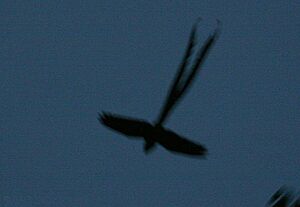Lyre-tailed nightjar facts for kids
Quick facts for kids Lyre-tailed nightjar |
|
|---|---|
 |
|
| Male in NW Ecuador | |
| Conservation status | |
| Scientific classification | |
| Genus: |
Uropsalis
|
| Species: |
lyra
|
 |
|
| Synonyms | |
|
Hydropsalis lyra |
|
The lyre-tailed nightjar (Uropsalis lyra) is a special bird known for its amazing tail. It belongs to a group of birds called nightjars. You can find this bird in South American countries like Argentina, Bolivia, Colombia, Ecuador, Peru, and Venezuela.
Contents
About the Lyre-tailed Nightjar
Birds are grouped into families and genuses. The lyre-tailed nightjar is in the same group, or genus, as the swallow-tailed nightjar. This genus is called Uropsalis.
There are also three types, or subspecies, of the lyre-tailed nightjar. They are named U. l. lyra, U. l. peruana, and U. l. argentina. These subspecies are slightly different depending on where they live.
What Does It Look Like?
The male lyre-tailed nightjar is famous for its super long tail feathers. These feathers can be more than twice as long as its body! This is how the bird got its name, as the tail looks a bit like a lyre musical instrument.
The female's tail is much shorter and not as fancy. Both male and female birds are about 23.5 to 28 centimeters (9 to 11 inches) long, not counting the male's long tail. The male's tail can be over 60 centimeters (24 inches) long.
Males weigh about 70 grams (2.5 ounces) and females about 77 grams (2.7 ounces). Their bodies are mostly brown. They have spots of grayish white, buff, and cinnamon colors. A wide tawny "collar" goes around their neck.
Their wings are also brown with many spots. The chest and belly are brown with tawny bars and spots. The female's head is more grayish, and her wing feathers have more reddish marks than the male's.
Different Subspecies
The U. l. peruana subspecies is a bit bigger and has a more reddish color. The U. l. argentina subspecies is the largest of the three. Its chest markings are whiter, and its tail feathers have gray tips instead of white.
Where Do They Live?
The lyre-tailed nightjar lives in the Andes mountains in South America. The U. l. lyra subspecies is found in western Venezuela, western Colombia, and Ecuador. It might also live in northern Peru.
The U. l. peruana subspecies lives on the eastern side of the Andes in Peru and into central Bolivia. The U. l. argentina subspecies is found in the Andes of northern Argentina and possibly southern Bolivia.
These birds usually live at high places, from about 1,100 to 2,100 meters (3,600 to 6,900 feet) above sea level. Sometimes, they can be found as low as 800 meters (2,600 feet) or as high as 3,500 meters (11,500 feet). They like to live in humid mountain forests, especially at the edges or in open areas. They often prefer cliffs and ravines near running water.
Behavior and Habits
How They Find Food
The lyre-tailed nightjar is active at dusk (evening) and at night. It hunts for food by flying out from a rock or a low branch at the edge of the forest. It might fly a short distance to catch an insect and then usually returns to the same spot.
Even though scientists haven't fully studied their diet, it's believed they eat insects, just like other nightjars. During the day, they rest on a branch or a cliff, often hidden by plants.
Reproduction and Life Cycle
It is thought that male lyre-tailed nightjars may mate with more than one female. Males perform special display flights to attract females in shared areas called leks.
The exact breeding season is not fully known, but it seems to change depending on the area. One nest that was studied was a simple scrape on the ground in an old fireplace. The female bird took care of the single baby bird by herself.
What Sounds Do They Make?
The lyre-tailed nightjar's song is a "rollicking" sound with 5 to 11 rising "wéeou-tee" notes. They mostly sing at dusk from a perch or the ground. They also sing while flying or chasing a female. The male's display flight includes a fast series of "weep-weep-weep-weepupup" sounds.
Conservation Status
The IUCN (International Union for Conservation of Nature) has listed the lyre-tailed nightjar as a species of "Least Concern." This means they are not currently in danger of disappearing. Even though we don't know the exact number of these birds, their population seems to be stable.
No immediate threats have been found for them. However, cutting down forests (deforestation) could become a problem for them in the future.



